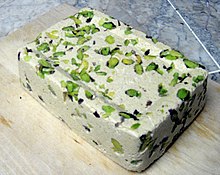 | |
| Type | Confectionery, dessert |
|---|---|
| Place of origin | Middle East |
| Region or state | Middle East, South Asia, Central Asia, Balkans, South Caucasus, North Africa, Horn of Africa |
| Serving temperature | Cold |
Halva (also halvah, halwa, halua, and other spellings; Arabic: حلوى Bhojpuri:𑂯𑂪𑂳𑂄, Hindi: हलवा, Persian: حلوا) is a type of confectionery that is widely spread throughout the Middle East and North Africa, the Balkans, and South Asia. The name is used for a broad variety of recipes, generally a thick paste made from flour, butter, liquid oil, saffron, rosewater, milk, turmeric powder, and sweetened with sugar.
Etymology
The word halva entered the English language between 1840 and 1850 from Romanian, which came from Ottoman Turkish: حلوى, romanized: helva, itself ultimately derived from Arabic: حلوى, romanized: ḥalwā, a sweet confection. The root in Arabic: ح ل و, romanized: ḥ-l-w, means "sweet". The original name for the confection was Persian: روغن خورديگ, romanized: rōɣn xwardīg, meaning "oil food".
History
The origin of halva is disputed, some say that it dates back to Arabia where a reference to halvah appeared in the 7th century, referring to a mixture of mashed dates with milk. others claim that it originated in Persia (modern day Iran). By the 9th century, the term was applied to numerous kinds of sweets, including the now-familiar sweetened cooked semolina or flour paste.
The first recipes of halva were documented in the 13th century Arabic cookbook Kitab al-Tabikh (The Book of Dishes), as well as an anonymous cookbook from 13th-century Al-Andalus. Halva was adopted by the Ottoman Turks, including a sesame-based version, and spread throughout their empire.
Types
Most types of halva are relatively dense confections sweetened with sugar or honey. Their textures, however, vary. For example, semolina-based halva's texture can be like a very buttery, moist clumpy couscous to something gelatinous and translucent, while sesame-based halva is drier and more crumbly.
Grain-based halva
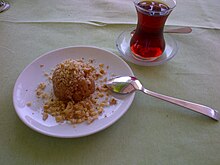
Grain-based halva is made by toasting flour or cornstarch in oil, mixing it into a roux, and then cooking it with a sugary syrup. Corn is rarely used.
Dishes made from wheat semolina include suji ka halwa (sooji sheera, rawa sheera) in India and irmik helvası in Turkey. The semolina is first toasted in fat, either oil or butter, to which water or milk and sugar are added as desired to create the preferred taste and consistency.
Dairy-based rice flour halva, known as Pathein halawa, is considered a Burmese delicacy native to the city of Pathein.
Sesame
Sesame halva is popular in the Balkans, Poland, the Middle East, and other areas surrounding the Mediterranean Sea. The primary ingredients in this confection are sesame butter or paste (tahini), and sugar, glucose or honey. Soapwort (called ‘erq al halaweh in Arabic; çöven in Turkish), egg white, or marshmallow root are added in some recipes to stabilize the oils in the mixture or create a distinctive texture for the resulting confection. Other ingredients and flavorings, such as pistachio nuts, cocoa powder, orange juice, vanilla, or chocolate are often added to the basic tahini and sugar base.
Sunflower
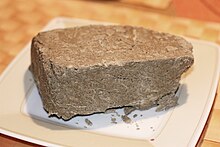
Sunflower halva is popular in the countries of the former Soviet Union as well as in Bulgaria and Romania. It is made of roasted ground sunflower seeds instead of sesame. It may include other ingredients, such as nuts, cocoa powder, or vanilla. In 1996 around 4–5 thousand tonnes of sunflower halva were being produced by Ukraine annually.
| This article needs to be updated. Please help update this article to reflect recent events or newly available information. (January 2025) |
Peanuts
In Argentina, Greek immigrants at the beginning of the 20th century created a kind of halva called mantecol from peanut butter, currently marketed under the name of Mantecol and also Nucrem. Such a product is widely consumed in the country.
Other
Floss halva
Pişmaniye (Turkish) or floss halva is a traditional sweet, prepared in Kocaeli, Turkey, made by flossing thin strands of halva into a light confection. Made primarily of wheat flour and sugar, the strands are continuously wrapped into a ball shape and then compressed. The result is a halva with a light consistency, similar to cotton candy. Floss halva can be found in regular and pistachio flavors, and there are brands with halal or kosher certifications.
A similar chickpea-based version of floss halva is popular in North India. It tends to be slightly denser and is often referred to as patisa or sohan papdi. In Chinese cuisine, a floss-like candy similar to pişmaniye or pashmak halva, known as dragon beard candy, is eaten as a snack or dessert.
A raw version of halva also has become popular among proponents of raw food diets. In this version, a mixture of raw sesame tahini, raw almonds, raw agave nectar and salt are blended together and frozen to firm.
Cultural and national variations
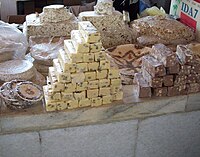
Azerbaijan

One regional variant is from Sheki where Şəki halvası halva refers to a layered bakhlava style pastry filled with spiced-nut mix and topped by crisscrossed patterns of a red syrup made from saffron, dried carrot and beetroot.
Greece
Halva is a traditional fasting food among Greek Orthodox who traditionally have food restrictions, especially from meat, on Wednesdays and Fridays throughout the year, for all of Great Lent and other fasting periods.
India


India has many types of halva, some unique to particular regions of the country. It is one of the popular sweets of India usually made from semolina.
The town of Bhatkal in Coastal Karnataka is famous for its unique banana halwa which is infused with either whole cashews, pistachio or almonds. This type of authentic halwa is a specialty of the Muslims of this town. The Udupi cuisine has halwa made from banana, wheat, ashgourd, and jackfuit.
It is speculated that halva (or halwa) is associated with Indian traditions and culture. Written records of sweets from Mānasollāsa mention a sweet called shali-anna, a type of semolina halwa which is today known as kesari in South India.
Tirunelveli in Tamil Nadu is known for its wheat halwa. Its preparation is a laborious process that "is slowly seeing this sweet disappear." Unlike other sweets, the extra ghee is not drained out but forms an outer layer. This increases the shelf life of the halwa. Locals attribute the unique taste of the halwa to the water of the Thamirabarani.
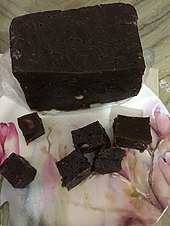
The history of Kozhikode Halwa in Kerala could trace back to Zamorin era. Zamorin invited chefs from Gujarat to prepare halwa for their royal feast. They were also granted places to stay beside royal kitchen. This settlement later evolved as sweet sellers street, nowadays known as SM (Sweet Meat) Street or Mittayitheruvu. Kozhikode halwa is made of pure coconut oil, not from ghee. Kozhikode halwa also builds religious harmony; Ayyappa devotees from neighboring states Karnataka and Andhra Pradesh buy halwa and chips like prasadam (sacred food). They distribute them among their neighbors and friends, who consume them with a religious zeal.
Iran
In Iran, halva (Persian: حلوا) usually refers to a related confection made from wheat flour and butter and flavored with saffron and rose water. The final product has a yellow, brown, or dark brown color. The halva is spread thin on a plate and left until it dries into a paste. Halva usually is served at wedding celebrations, religious ceremonies and funerals.

Halva Ardeh is the Iranian term for tahini-based halva, and may or may not include whole pistachios. Ardeh is processed sesame in the form of paste, usually sweetened with syrup.
Israel
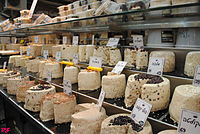
Tahini halvah (Hebrew: חלווה) is very popular in Israel and among Jews in the diaspora. Israeli halvah is made from sesame tahini and sugar. It is generally sold in slabs, with or without nuts. Vanilla, or vanilla with chocolate swirls are perhaps the most common, but there are many different varieties. Halvah is parve. It is often served as a breakfast component at Israeli hotels, and even used in specialty ice cream.
Myanmar (Burma)
Main articles: Pathein halawa and Sanwin makinIn Myanmar (Burma), halawa (ဟလဝါ) generally refers to Pathein halawa (ပုသိမ်ဟလဝါ), a Burmese confection or mont made with glutinous rice flour, rice flour, milk, and coconut shavings originating from the Irrawaddy delta town of Pathein. Another popular semolina-based confection, which is known as sooji halawa in India, is called sanwin makin in Myanmar.
Turkey
In Turkey halva is served for special occasions such as births, circumcisions, weddings and religious gatherings. The tradition is for semolina halva to be served at funerals, when someone leaves or returns from Hajj, and during Ramadan.
For this reason, flour (un) halva is also called in Turkish ölü helvası, meaning "halva of the dead". The expression "roasting halva for someone" suggests that the person referred to has died.
United States
Halva can be found in ethnic Indian, Jewish, Arab, Persian, Greek, Balkan community stores and delicatessens as well as natural food stores. Besides being imported, it is manufactured in the United States, with the largest producer being Brooklyn-originated Joyva.
See also
References
- ^ Clark, Melissa (March 24, 2004). "For Halvah, Use 1/2 Cup Nostalgia". The New York Times. Retrieved November 15, 2020.
- ^ Davidson, Alan (1999). The Oxford Companion to Food. Oxford: Oxford University press. p. 378. ISBN 0-19-211579-0.
- Sharar, Abdul Halim (1994). Lucknow: the last phase of an oriental culture. Oxford University Press. p. 165. ISBN 9780195633757.
- Hosking, R. (2010). Food and Language: Proceedings of the Oxford Symposium on Food and Cooking 2009. Proceedings of the Oxford Symposium on Food and Cookery Series. Prospect Books. p. 202. ISBN 978-1-903018-79-8. Retrieved April 11, 2022.
- Szokovski, Miriam. "How to Make Halva at Home".
- ^ Marks, Gil (2010). "Halva". Encyclopedia of Jewish Food. HMH. ISBN 9780544186316.
- Halvah Archived March 6, 2016, at the Wayback Machine, Random House Dictionary, 2009
- "American Heritage Dictionary". Retrieved February 21, 2019.
- ^ Foundation, Encyclopaedia Iranica. "Welcome to Encyclopaedia Iranica". iranicaonline.org. Retrieved April 23, 2021.
The origin of ḥalwā in Persia dates from the pre-Islamic period. References are found in the Middle Persian text of Xōsrōv ud rēdak (ed. Monchi-zadeh, secs. 38-40) to two kinds of sweetmeats (rōγn xwardīg): (1) summer sweetmeats, such as lōzēnag (made with almond), gōzēnag (made with walnut), and čarb-angušt (made from the fat of bustard or gazelle and fried in walnut oil); and (2) winter sweetmeats, such as wafrēnagītabarzad flavored with coriander (gišnīz ačārag). Many references are found to ḥalwā in classical Persian texts, but rarely do they provide details concerning ingredients.
- Davidson, Alan; Jaine, Tom (2014). The Oxford Companion to Food. Oxford University Press. p. 378.
- Marks, Gil (November 17, 2010). Encyclopedia of Jewish Food. HMH. ISBN 978-0-544-18631-6.
Halva is a dense confection. The original type is grain based, typically made from semolina, and another kind is seed based, notably made from sesame seeds. Origin: Persia
- Kobren, Gerri (August 17, 1983). "What's this stuff called halvah?". The Herald News (Passaic, New Jersey). Independent Press Service. p. C-4. Retrieved August 17, 2022 – via Newspapers.com.
- "Suji ka Halwa | Sheera Recipe". July 3, 2021.
- Shah, Khushbu (June 8, 2017). "Halwa vs. Halvah: An Investigation". Taste. Retrieved March 8, 2019.
- Segnit, Niki (2019). Lateral Cooking. Bloomsbury. p. 83. ISBN 9781635574418.
- Arndt, Alice (1999). Seasoning Savvy: How to Cook with Herbs, Spices, and Other Flavorings. Taylor & Francis. p. 215. ISBN 978-1-56022-031-2.
- "Halva Ethnological Museum of Thrace". Archived from the original on July 3, 2007.
- "HALWA+WITH+PISTACHIO" "Halwa with pistachio". FAO Food and Nutrition Paper. 25–28. Food and Agriculture Organization of the United Nations. 1982.
- Nistor, E.; Hoha, G.; Usturoi, M.; Alley, M. S. (2014). "Comparison of three sunflower halva assortments from Romanian market" (PDF). Analele Universității din Oradea, Fascicula: Ecotoxicologie, Zootehnie și Tehnologii de Industrie Alimentară. 14 (B): 329–336. S2CID 54789320.
- "Халва. Общие технические условия", Гост 6502-2014, Межгосударственный совет по стандартизации, метрологии и сертификации, 2014
- "Халва". ГОССТАНДАРТ. "Halva" (in Russian). GOSSTANDART. Archived from the original on January 13, 2021. Retrieved May 1, 2019.
- Volodymyrovych, Dmytro (1996). Ukraine 5 years of Independence. Politische Geschichte. ISBN 9789667127008.
- Amsden, Matt (2006). RAWvolution: Gourmet Living Cuisine. HarperCollins. ISBN 978-0-06-084318-2.
- "Visions of Azerbaijan Magazine ::: SHEKI'S MYSTERIES – STAINED GLASS AND THE SWEETEST HALVA". Visions of Azerbaijan Magazine.
- "Mətbəx sirləri: Şəki halvası - VİDEO". Milli.Az. March 20, 2013.
- Moskin, Julia (April 11, 2016). "Sesame Extends Its Sweet Reach Beyond the Middle East". The New York Times.
- Bahadur, Om Lata (1996). The book of Hindu festivals and ceremonies (3rd ed.). New Delhi: UBS Publishers Distributors ltd. p. 172. ISBN 81-86112-23-5.
- "ash gourd halwa recipe kashi halwa kushmanda halwa dumroot halwa". Hebbar's Kitchen. February 12, 2019. Retrieved March 22, 2024.
- "jackfruit halwa recipe seasonal dessert". Udupi recipes. June 3, 2017. Retrieved March 22, 2024.
- "Full text of "Indian Food Tradition A Historical Companion Achaya K. T."". archive.org. Retrieved January 30, 2019.
- Rajagopalan, Ashwin (May 10, 2018). "Tirunelveli Halwa: Tamil Nadu's Legendary Red Wheat Halwa You Need to Try". NDTV Food. Retrieved August 20, 2019.
- "kozhikode-calicut-halwa-food-history". www.onmanorama.com.
- Basheer, K. p m. (December 22, 2017). "a-sweet-place-in-their-hearts". The Hindu.
- Naha, Abdul Latheef (December 13, 2015). "kozhikodan-halwas-religious-flavour". The Hindu.
- Fair, Chris (August 3, 2008). Cuisines of the Axis of Evil and Other Irritating States. Rowman & Littlefield. ISBN 978-1-59921-634-8. Retrieved November 1, 2020.
- "Recipe". Archived from the original on February 19, 2009. Retrieved December 5, 2008.
- Floor, Willem M. (2003). Traditional Crafts in Qajar Iran (1800-1925). Mazda Publishers. ISBN 9781568591476.
- Ying, Chris; Redzepi, René (2018). You and I Eat the Same: On the Countless Ways Food and Cooking Connect Us to One Another (MAD Dispatches). Vol. 1. Artisan Books. ISBN 9781579658564.
- Marks, Gil (1996). The World of Jewish Cooking. Simon & Schuster. p. 210. ISBN 978-0-684-82491-8.
- "Four stops for halvah". Haaretz.
- "The ice man cometh". Haaretz.
- Tremblay, Pinar (May 18, 2015). "Semolina halva unites Turks in times of joy, sorrow". Al Monitor (Turkey). Retrieved August 20, 2019.
In Anatolia, the peninsula of land that today constitutes the Asian part of Turkey, halva has a social mission: it is shared with family and friends at joyous events such as weddings, births, circumcision ceremonies and religious celebrations. Traditionally, it is also served during Lent, at funerals and when someone leaves for hajj and is welcomed back home.
- DeLafuentenov, Charles (November 8, 2004). "A Longtime Brooklyn Company That's Known for Its Sesame Sweet". The New York Times.
- Confectionery
- Vegetarian cuisine
- Arab desserts
- Balkan cuisine
- Burmese desserts and snacks
- Iranian desserts
- Israeli desserts
- Israeli confectionery
- Jewish desserts
- Levantine cuisine
- Ottoman cuisine
- South Asian cuisine
- Uzbekistani cuisine
- Tajik cuisine
- Turkish desserts
- Halva
- Bulgarian cuisine
- Greek cuisine
- Semolina dishes
- Ancient dishes
- Lenten foods
- Breakfast
- Albanian cuisine
- Indo-Caribbean cuisine